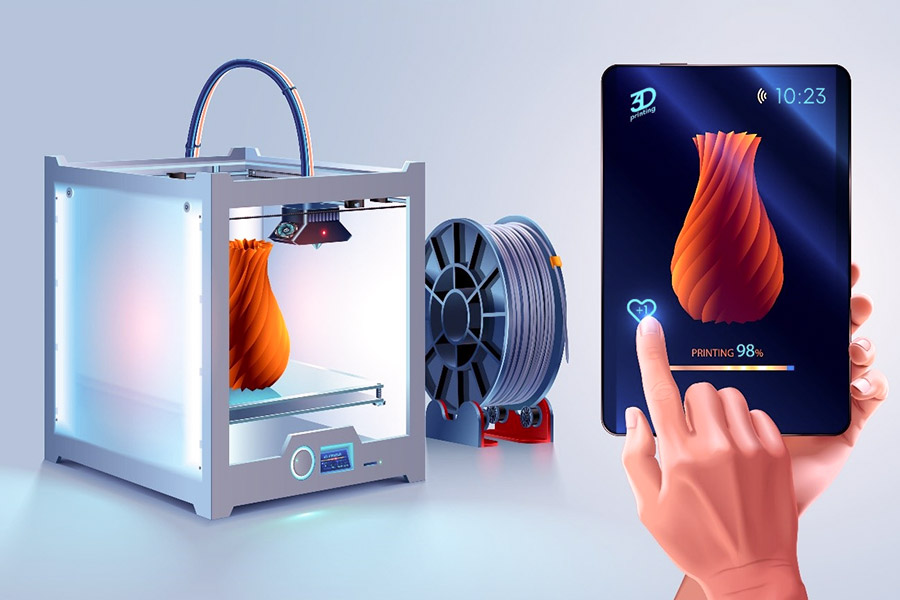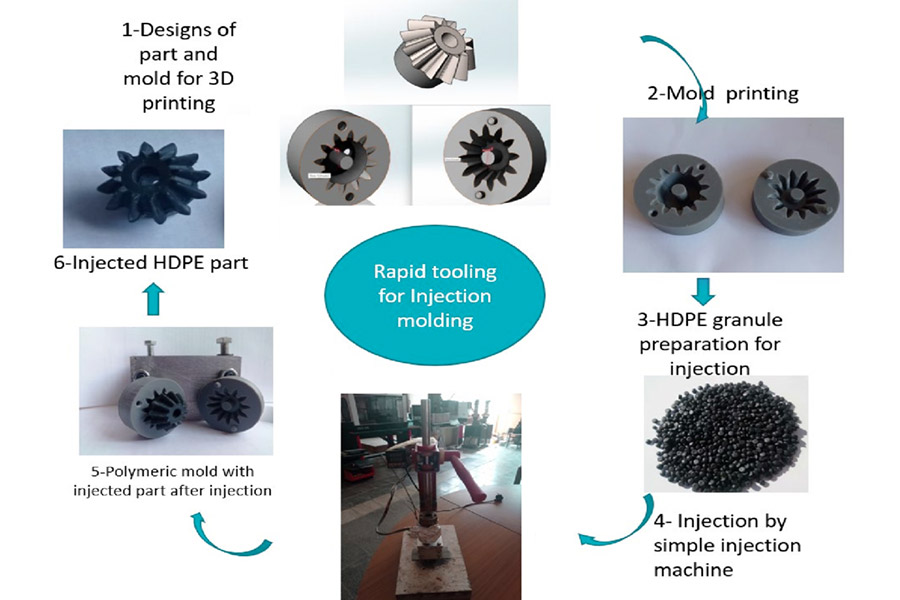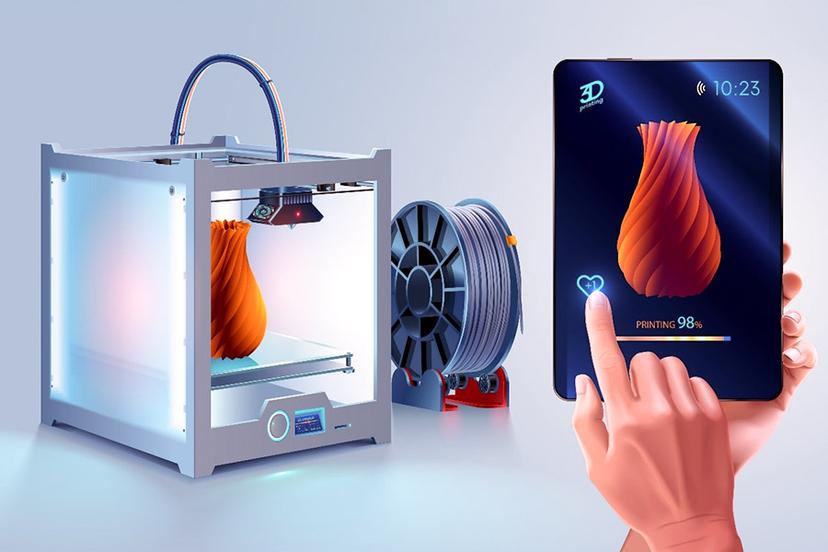In today's fast-changing business environment, time is money and efficiency is the difference between success and failure. Especially in the early stages of product development, designers and engineers face a huge challenge: how do you quickly and accurately turn ideas into physicalprototypesfor functional validation, user testing, and market feedback? Rapid prototyping technology emerged in response to the requirements of the times and provided a variety of solutions to this problem. This article will delve into the varioustypes ofrapid molding and reveal how they play a key role in different scenarios and serve as an effective bridge between creativity and reality.
What is Rapid Prototyping?
Rapid prototyping,It is the use of 3D computer-aided design (CAD) to quickly manufacture physical parts, models, or assemblies. The creation of parts, models, or assemblies is typically done using additive manufacturing, often referred to as 3D printing. Rapid prototyping is the process of creating something that can be used to quickly evaluate a product. In engineering, a prototype is an early version of a product. Rapid prototyping enables companies to test and analyze technology.
When the design closely matches the proposed end product, it is called a high-fidelityprototype, and conversely, a low-fidelity prototype has a distinct difference between the prototype and the final product.
In other words,rapid prototyping is a testing method. You can analyze the future development of the product and its success with customers. Therefore, the results of the analysis will tell you whether it works or not. Companies use this process at every stage of product development. Efficiency makes the process cheaper and faster. This provides greater flexibility and room for error in product manufacturing. This is more beneficial than other methods in the long run.

How does rapid prototyping work?
- Design Creation:Use CAD software to create a digital 3D model of an object. This phase is critical to laying the groundwork for the prototype.
- Data Preparation:The CAD model is processed and converted into a format suitable for the chosen rapid prototyping technique, usually an STL file.
- Machine Settings:Prepare, calibrate, and loadrapid prototyping machines with appropriate materials(plastic, resin, or metal powder).
- Prototyping:The machine builds the prototype layer by layer according to the specifications of the CAD model.
- Post-processing:After the build process, prototypes often require post-processing to achieve the desired surface finish or mechanical properties. This may include sanding, painting, or assembling.
What are the types of rapid prototyping?
1.SLA
SLA is an industrial 3D printing or additive manufacturing processthat uses a computer-controlled laser to build a part in a stack of UV-curable photopolymers. Lasers are used to trace and cure cross-sections of part designs on liquid resin surfaces. The cured layer is then lowered directly below the surface of the liquid resin and the process is repeated. Each newly cured layer adheres to the layer below it. This process continues until the part is complete.
- Material used:SLA mainly uses photosensitive resins as raw materials. The material solidifies rapidly when irradiated with an ultraviolet laser beam.
- Velocity:SLA technology has a fast processing speed, short product production cycle, and does not require tools and molds.
- Cost:Despite the high cost of building, using, and maintaining an SLA system, its ability to handle complex prototypes and molds makes it irreplaceable in some use cases.
- Industries:SLA technology is widely used in industries such as aerospace, automotive, and healthcare to manufacture complex and high-precision parts and prototypes.
2.SLS
SLS is one of five additive manufacturing processes offered by Protolabs. In the SLS process, the computer-controlled CO2The laser is drawn from the bottom up onto the hot bed of the nylon-based powder, where it gently sinteres (fuses) the powder into a solid. After each layer, the drum spreads a new layer of powder on the bed and the process is repeated. SLS uses rigid nylon or elastomeric TPU powders that resemble actual engineering thermoplastics, so parts exhibit greater toughness and accuracy, but have rough surfaces and lack fine detail. SLS offers a large build volume that can produce parts with highly complex geometries and create durable prototypes.
- Materials used:SLS technology uses thermally bonded powders as raw materials, such as metals, ceramics, paraffin, and polymer powders.
- Velocity:SLS technology is characterized by short production cycles and no support required during the molding process, enabling the rapid production of complex 3D solid parts.
- Cost:SLS has a wider range of material utilization compared to SLA, and unsintered powders can be reused, reducing costs.
- Industries:SLS technology is widely used in industries such as aerospace, automotive, electronics, and construction for rapid manufacturing of prototypes, molds, and low-volume parts.
3. FDM
FDM uses an extrusion method to melt and re-cure a thermoplastic resin(ABS, polycarbonate, or ABS/polycarbonate blend) in layers to form a finished prototype. Because it uses a real thermoplastic resin, it is stronger than binder jetting and may be of limited use in functional testing.
- Material used:FDM technology uses non-toxic raw materials, such as thermoplastics. These materials have no chemical changes during the molding process, and the warpage of the parts is minimal.
- Velocity:The molding speed of FDM technology is relatively fast, and the system calibration is automatically controlled, which improves the production efficiency.
- Cost:FDM technology has a high utilization rate of raw materials and a long material life, which reduces costs. However, support removal can be relatively complex, and raw materials can be expensive.
- Industries:FDM technology is widely used in industries such as consumer goods, education, construction, and automotive to manufacture prototypes, teaching models, and parts.
4.DLP
DLP is an excellent rapid prototyping technique because of its speed and efficiency. It uses a digital projector screen to flash a single image of each layer across the platform, curing the photopolymer. DLP is particularly useful for applications that require high speeds without compromising resolution.
- Materials used:DLP technology typically uses photosensitive resins or similar materials that solidify rapidly when exposed to a specific light source.
- Velocity:DLP technology is characterized by high resolution and high response speed, which can quickly generate seamless digital images, and is suitable for manufacturing high-precision prototypes.
- Cost:The cost of DLP technology depends on the equipment and materials used, but its advantages in high definition, high contrast, and high dust resistance make it competitive in certain applications.
- Industries:DLP technology is used in projection systems, display technology, and prototyping, especially where high definition and contrast are required.
5.LOM
LOM is a unique rapid prototyping technique that involves layering glued paper, plastic, or metal laminates and then cutting them into shape with a laser or knife. LOM is particularly well-suited for rapid prototyping because of its cost-effectiveness and ability to produce large parts.
- Materials used:Materials such as paper, sheet metal, and polymer sheets are mainly used.
- velocity: Relatively fast, as the model is built by cutting and gluing layer by layer.
- Cost:Low, mainly due to the use of low-cost materials and relatively simple processes.
- Industries:Used to create visual prototypes and marketing props for aerospace, automotive, healthcare, and more.
6. Binder jetting
Binder jetting is a rapid prototyping process that involves depositing liquid adhesive layer by layer onto a powder bed to create an object. The technology is valued for its versatility in material selection and its ability to create full-color prototypes.
- Materials used:Powder materials such as metals, ceramics, etc.
- Velocity:Fast, as the manufacturing cycle can be greatly shortened.
- Cost:Relatively low, but depending on the type and complexity of the powder used.
- Industries:It is widely used in the manufacture of high-precision 3D structural models such as automotive parts, medical devices, and aerospace parts.
7.DMLS
DMLS is an advanced rapid prototyping technique that uses a laser to sinter metal powders layer by layer to create metal parts. DMLS is known for its precision and ability to produce complex geometries that are often difficult to manufacture with traditional methods.
- Materials used:Metal powders, such as nickel-based, cobalt-based, iron-based alloys, etc.
- Velocity:Relatively fast, but depends on model complexity and size.
- Cost:Higher due to the use of metal powders and sophisticated laser equipment.
- Industries:It is mainly used to manufacture high-stress components, complex components and irregular components that cannot be processed by traditional processes, such as aerospace, automotive, medical personalized parts manufacturing, etc.
8.EBM
EBM is an advanced technology that uses a high-energy electron beam to melt and fuse metal powder particles. This method is particularly suitable for applications that require high strength and heat resistance.
- Materials used:Metal powders, such as titanium alloys, cobalt-chrome alloys, etc.
- Velocity:Usually faster than SLM because the powder layer is thicker and the electron beam scans faster.
- Cost:Higher, but may reduce the total cost due to high material utilization.
- Industries:It is used in the manufacture of lightweight monolithic structures and high-performance complex parts in the aerospace and industrial sectors, as well as in the manufacture of porous orthopedic implants in the medical sector.
9.SLM
SLM is an important technique in the rapid prototyping process and is widely used mainly because of its precision and strength. This technology uses a high-power laser to completely melt and fuse metal powder, layer by layer, to create strong metal parts.
- Materials used:Metal powders, such as stainless steel, titanium alloys, etc.
- Velocity:Relatively fast, depending on model complexity and size.
- Cost:High, but high material utilization, reducing waste.
- Industries:It is widely used in aerospace, medical equipment, automobile manufacturing and other fields to manufacture high-precision and high-performance metal parts.
10.PolyJet printing
PolyJet printing is a rapid prototyping technique known for its precision and versatility. It works by spraying a layer of curable liquid photopolymer onto the build tray, and these resins are immediately cured by UV light. This method allows for the creation of parts with multiple material properties and colors in a single print.
- Materials used:Liquid photopolymer resin that supports a wide range of colors and materials.
- Velocity:Fast model printing in a wide range of colors and materials can be achieved in a short time.
- Cost:Depends on the material used and the complexity of the model.
- Industries:High-fidelity models, artworks, architectural models, and prototypes for the production of automotive parts in the fields of product design, medical, artistic creation, architecture, and automotive manufacturing.
11. Injection molding
Although injection molding has not traditionally been classified as rapid prototyping, it has evolved with the development of rapid prototyping technology. It involves injecting molten material into a mold to produce parts in large quantities. Rapid tooling can create molds quickly,making injection molding a viable method for rapid prototyping.
- Materials used:Plastic materials like ABS, nylon, etc.
- Velocity:Relatively fast, but requires mold design and manufacturing time.
- Cost:Depends on the complexity of the mold and the number of productions.
- Industries:It is widely used in mass production in automotive, electronics, toys and other industries.

12. CNC machining
CNC machining is a subtractive manufacturing processthat is essential in the field of rapid prototyping. It involves the use of a computer-controlled machine tool to remove layers from a solid block of material to shape the desired part.
- Materials used:metal, plastic, wood, and other materials.
- Velocity:It depends on the complexity of the machining and the capabilities of the machine.
- Cost:Higher because of the need for CNC machines and precision tools.
- Industries:It is widely used in the manufacture of complex parts in aerospace, automotive, healthcare and other fields.
13. Water jet cutting
Waterjet cutting is an innovative technology in the field ofrapid prototypingthat uses a high-pressure stream of water, usually mixed with abrasive particles, to cut through materials. This technology is known for its precision and versatility in cutting a wide range of materials.
- Materials used:metals, plastics, glass, and other materials.
- Velocity:Relatively fast, but depending on the type and thickness of the material.
- Cost:Lower, but requires high-pressure water flow equipment and cutting tools.
- Industries:It is used for the cutting of complex shape materials in the fields of automobile manufacturing, aerospace, and art creation.
Why is rapid prototyping important?
|
Advantage
|
Description
|
|
Shorten the development cycle
|
Design ideas can be quickly transformed into prototypes with certain functions or parts manufactured directly, accelerating the product development process.
|
|
Reduce production costs
|
By reducing the number of trial productions and avoiding risks caused by mass production, production costs are effectively reduced.
|
|
High degree of technology integration
|
It integrates various technologies such as mechanical engineering, CAD, reverse engineering technology, layered manufacturing technology, CNC technology, material science, laser technology, etc.
|
|
Wide selection of materials
|
Can be manufactured using a variety of metallic and non-metallic materials, including plastics, metals, ceramics, and more.
|
|
Easy to modify and optimize
|
Due to the digital design and manufacturing process, product designs can be easily modified and optimized.
|
|
High degree of customization
|
Able to carry out customized production according to the specific needs of customers to meet diversified market demands.
|
FAQs
1.What are the four types of prototype models?
The four main types of models include:(1)SLAis an industrial 3D printing, or additive manufacturing, process that builds parts in a pool of UV-curable photopolymer resin using a computer controlled laser. The laser is used to trace out and cure a cross-section of the part design on the surface of the liquid resin. The solidified layer is then lowered just below the surface of the liquid resin and the process is repeated. Each newly cured layer adheres to the layer below it. This process continues until the part is completed.②SLSis one of five additive processes available at Protolabs. During the SLS process, a computer-controlled CO2laser draws onto a hot bed of nylon-based powder from the bottom up, where it lightly sinters (fuses) the powder into a solid. After each layer, a roller lays a fresh layer of powder on top of the bed and the process repeats. SLS uses either rigid nylon or elastomeric TPU powders similar to actual engineering thermoplastics, so parts exhibit greater toughness and are accurate, but have rough surface and lack fine details. SLS offers a large build volume, can produce parts with highly complex geometries and create durable prototypes.(3)FDMuses an extrusion method that melts and re-solidifies thermoplastic resin (ABS, polycarbonate, or ABS/polycarbonate blend) in layers to form a finished prototype. Because it uses real thermoplastic resins, it is stronger than binder jetting and may be of limited use for functional testing.④DLPis an excellent rapid prototyping technology because of its speed and efficiency. It uses a digital projector screen to flash a single image of each layer across the entire platform, curing the photopolymer resin. DLP is particularly suitable for applications that require high speed without compromising resolution.
2.What are the advantages of rapid prototyping?
The main advantages of rapid prototyping are: shortened development cycle, reduced production costs, high technology integration, wide selection of materials, high degree of customization, easy modification and optimization, etc. The above advantages may vary depending on the specific rapid prototyping technology and application scenarios. In practical applications, the appropriate rapid prototyping technology needs to be selected according to specific needs and conditions.
3.What is an example of rapid prototyping?
Rapid prototyping has a wide range of applications in specific industries. For example: Medical device prototypes: Through rapid prototyping technology, manufacturers of medical devices and instruments can quickly produce prototypes for functional testing and ergonomic optimization. Auto parts: In the automotive industry, rapid prototyping technology is used to manufacture complex-shaped parts, such as engine parts, body parts, etc., for performance testing and verification.
4.What are the best materials for rapid prototyping?
For different types of rapid prototyping, choosing the right material is crucial. ABS: has good mechanical properties and thermoplasticity, and is suitable for extrusion molding technologies such as FDM. Nylon: It has high strength and wear resistance, and is suitable for powder sintering technologies such as SLS. Metal: such as titanium alloy, stainless steel, etc., suitable for applications requiring high strength and high temperature resistance, usually produced through technologies such as SLS or DED.

Summary
Rapid prototyping technology provides designers and engineers with an efficient and low-cost means to quickly transform design ideas into physical prototypes or directly manufacture parts. Different types of rapid prototyping technologies have their own advantages and disadvantages and are suitable for different design stages and product types. Designers should choose appropriate prototyping methods based on specific needs to speed up the product development cycle and improve product quality and user satisfaction.
Disclaimer
The content on this page is for reference only. Longsheng does not make any express or implied representation or warranty as to the accuracy, completeness or validity of the information. No performance parameters, geometric tolerances, specific design features, material quality and type or workmanship should be inferred as to what a third party supplier or manufacturer will deliver through the Longsheng Network. It is the responsibility of the buyer seeking a quote for parts to determine the specific requirements for those parts.Please contact us for more information.
Longsheng Team
This article was written by multiple Longsheng contributors. Longsheng is a leading resource in the manufacturing sector, withCNCmachining,sheetmetalmanufacture,3D printing,injection molding,metal stamping, and more.






